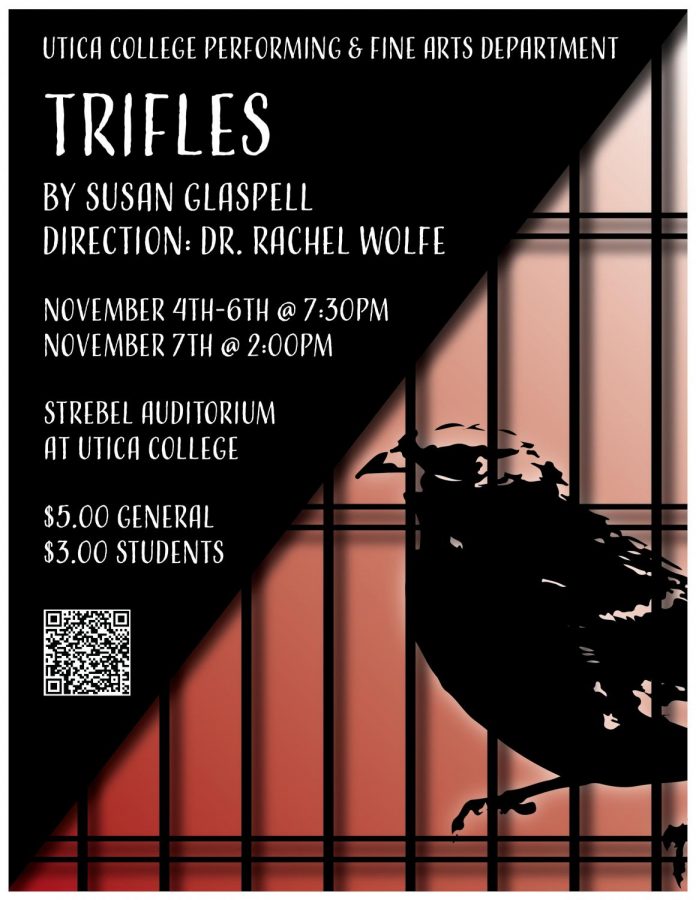‘Trifles’ Review: Never jump to conclusions
Utica College Performing & Fine Arts Department
The Fall 2021 production of “Trifles” took the stage in Strebel Auditorium Nov. 4, 5 and 6 at 7:30 p.m. and Nov. 7 at 2 p.m.
November 11, 2021
On Friday, Nov. 5, I attended the one-act show “Trifles” directed by Rachel Wolfe, which was not only a show for an audience to see, but also served as a case study for her directing class.
“Trifles” is a story that follows a county attorney (Mr. Henderson), witness (Mr.Hale) and sheriff (Mr.Peters) trying to unravel the mystery of a man’s death which all evidence points to his wife being the killer. However, over the course of the show, things began to unravel as the wives of the sheriff and witness (Mrs. Peters and Mrs.Hale) both realize that the victim’s wife may have been suffering from possible abuse caused by her husband.
Going into this show, I honestly didn’t really know what to expect. The story sounded compelling and I was interested from when I first heard about it. I can gladly say that this show is definitely a hidden gem among other plays. “Trifles” not only teaches the value of looking at all the evidence, even evidence that may not look like much, but it also teaches the values of how bias leads to nothing more than a dead end.
The men of the play (Mr. Henderson, Mr. Hale and Sheriff Peters) didn’t seem to bother paying attention towards information that could have showed signs of something other than the victim’s wife being a killer. From the start of the play, it seemed as if they all were already in agreement on what happened and why it happened. However, the sheriff’s wife and Mr. Hale’s wife, Mrs. Peters and Mrs. Hale, both believed something was not adding up.
As the play progressed, I found myself slowly getting sucked into the story, wondering what was going to happen next. As the wives continued to uncover more evidence that wasn’t previously found, a new story seemed to be weaving together, a story that presented itself as a reason to why the murder victim was killed.
Toward the end of the play, Mrs. Hale and Mrs. Peters found an old bird cage that Mrs. Hale believed belonged to the victim’s wife. Mrs. Peters knew the victim’s wife always wanted a bird of her own, so it would make sense for her to have a birdcage. However, shortly after finding the birdcage, they found a small box and upon opening it, saw a horrifying sight… a dead bird in the box.
I personally believe this was a moment that showed more than just a gruesome sight. I took the bird incident as a symbol of how the victim treated his wife, which in this case, meant he treated her very poorly. Overall though, the story itself was interesting to watch and the tension building was definitely there when certain moments arrived.
However, it’s not just the story that brings a play to life. The acting and technical aspects of the backstage also help tremendously. The performances from each of the actors was on point for the moments where tensions rose. I especially loved the acting done by Gabrielle Koeing, who played Mrs. Wright, the victim’s wife. During the beginning of the play, Mr. Hale is recounting the events of how he found the victim. He explained how the wife of the victim was sitting and rocking in her chair, looking worried and guilty of something. While going through his story, explaining her laughter and other gestures she did during their interaction, Koenig mimicked the laughter and gestures perfectly in response to when Mr. Hale brought them up.
The technical aspects of the lights and the set also helped with the scenes and show itself. This was because the lights would dim or brighten depending on the situation of the scene, especially when the tensions rose to the climax. The bird scene was a good example of this.
The set helped not only bring life to the story, but it brought a sense of the time period to the story too. The play is set in 1916, so they designed the set to represent a house that fit that time period.
Overall, the show was done very well and the way it ended was interesting because it left you wanting more. The ending was just a simple response to a question with a bigger reason behind it. The county attorney asked Mrs. Hale what way the victim’s wife was quilting and Mrs. Hale responded: “It’s called knot it.” This line here, while it seemed like a weird spot for the story to end, made sense after I thought about it. I believe that the final line was Mrs. Hale trying to prove the point that what they were searching for was not going to be the ending, but a dead end.
Overall, I believe this play was a hidden gem, but the acting, technical design and general execution are what truly made it so great.





































































































































